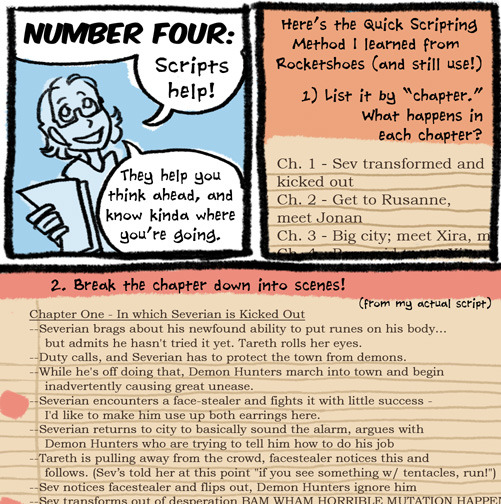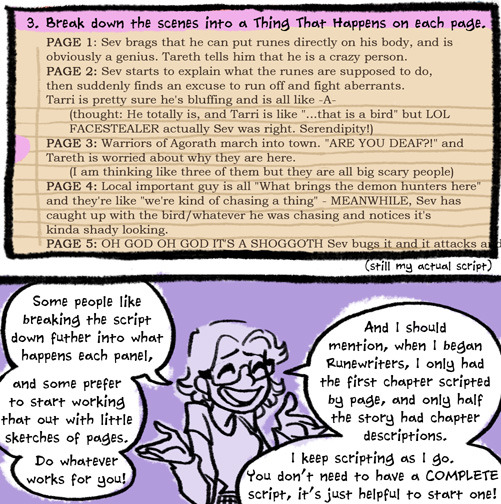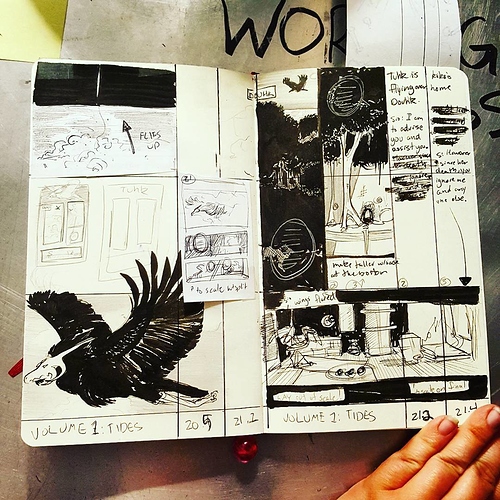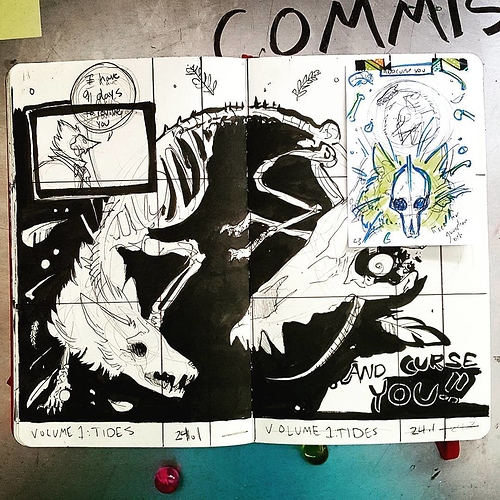First, I write down the story and plot while I'm going through my regular day. I use OneNote on my phone because it allows me to continue writing on my iPad and Windows Pc.
Once I'm done with that and I have to start drawing, I draw a quick sketch on paper to design the panels and start drawing the real thing digitally.
I use music to draw and I'm on Tapastic a lot to keep me motivated.
Here's my process for scripting --
 18
18
 13
13
(from this post10)
But honestly for the thumbnail vs dialogue thing, I go back and forth and do them together! I start writing out the script, and draw little scribbles of a page in the margins -- sometimes I start out with those scribbles, with little indicators of what dialogue I imagine going with what panel, sometimes I start with the rough beats of dialogue that I imagine in a script form and then start sketching out panel layouts -- it depends on what's working for me that day.
As you can see, initial scribble sometimes gets reworked, or redrawn -- and sometimes I change my mind on dialogue once I've scribbled up a layout I like for the page! The first thing you put down doesn't have to be Your Final Answer; it can just be a rough idea that you adjust or change in the next step!
TBH my writing process is all over the place. I'm definitely not a chronological writer so I just write what comes to mind first and then organize my ideas later.
I do need the script done before I start drawing to avoid plot holes (oh the joys of not being a chronological thinker). What I basically do is divide my script into "pages" and then go straight to drawing. My teachers would silently kill me if they found out I skip the thumbnail stage lol, but you got to do what works best for you ^-^
EX.
------pg. 36
I trip over the stone steps in the alley. Clenching my teeth, I quickly wipe the dirt from my bloody elbows. I try not to think about my other team members. They probably found Mya already with Nalia’s strange sixth sense.
Out of nowhere, a face blocks my field of view. I nearly scream.
J’ias: You look like you just saw the dead.
------ pg. 37
Tale: Who are you!
J’ias: I would like to thank you for supporting my cult. Your 42 Daln is much appreciated.
That said, process is different for everyone and it does take some time to figure it out so don't get discouraged about it ^-^
I guess bottomline is that you need to find your own creative process that works best and you can only find it through doing it. Once you you have done a few chapters you'll probably have refined or changed the process completely. I have done so. Each new chapter I change something, and sometimes the process needs to adapt to the story.
My first chapter had very little dialogue, so I hardly script anything. My third chapter had to do with background setting, so I picked a poem I wrote (as a song) and some old chronicles.
I keep writing down ideas in a semi-ordered big timeline, from which I extract the story I am telling. This is good to keep a consistent big-picture background when I don't like to bring it all into the story.
I love writing narrative text, so for the chapter I'm working on I actually wrote the "argument" in novel-style first of all, to have a clear story to tell first. Then comes the process of scripting that into pages and dialogues. I don't want to have an annoying narrator voice, I think that drives attention away from the art details, so I sometimes have to invert my story and use images from other events to build up knowledge for the reader so I can bring tension, confusion, deep thoughts...
But yeah, do the thumbs, they are very important!
I make my script detailing every page, every action, every word. I have always been an.obsessive planner. I like to use the scripting and thumbnail stages to work out the pages so they look their best, adjust the amount of text and where that text will go.
When doing thumbnails, I do it in a storyboard style format (having been trained in animation this is my preference lol). The images on the left is roughly what a panel would look like amd the text on the right is dialogue and action description.
(Inking in a car is not my preference lol)
Once I am generally satisfied I jump into the actual pages and start penciling. Then inking. I scan inks, clean them up then add screentones and text, then post!
I like preplanning ahead of time as much as possible. This makes less guess work later so I can fly smoothly through pages without second thoughts. (Most times lol)
knowing what the story is about, who is it about, and where is it set.
then I figured out the character background and their past before the story started in 1st chapter,
and most importantly, knowing what 'drove' their characters (their main motivation in life)
so I know what they gonna say, what they wanna say, how they're saying it, the character start to come alive, sort of
I also outlined the plot points at this point
then I thumbnails a bunch, with clear idea of whats gunna happen, before I put all these thumbnails together into one page
then moving on from that 
Heres what I do. I'm a very visual person, I hate writing down what the character is going to do or is doing, I would rather draw all that out. so yeah, basically I thumbnail everything and add very short speech bubbles that explain the brief idea of what the characters are gonna say. I add the final dialouge as I go when i'm drawing the panels. basically, I draw everything out and the positions with basic idea of the speech, and finalize the speech later.
For my current comic Chuck & Clark I take it in strides. I have a skeleton plot planned, but I handle things chapter by chapter and honestly my plans have only gotten better for this particular series because of it. I usually write about five chapters ahead of what I'm about to sketch and I end up sketching the entirety of a chapter before going and meticulously bringing one page from sketch phase to finished before going on into the next.
my approach is similar to shazzbaa. I plot the story, break it into chapters and then break each chapter into a number of pages. each page of script is a page of comics. I break the page into a number of shots so each panel is a shot ( long shot, clue up, Extreme closeup)
once I have scripted a chapter. I rough out each page on A4 paper folded in half, using simple stick figures thinking about page turns ( also helps work out when the page is what if you have a double page spread or splash page across 2 non-consecutive pages). If I need to add more panels I add them at this point and update the script at the same time. I end up with a script and a series of rough pages ready to work up into final page.
I'm new to scripting and comics!
For me I write out dialogue and descriptions as I write my plot and outlines since for me since I started writing stories (novels) I have a really vivid imagination and I can clearly see each scene as I write so it comes more naturally, but the drawing part... hence why I'm working with other comic writers and artists, and I'm learning quite a lot from them.
If you already have plot lines divide those into sub plots/scenes - there isn't always a need for too much words since a picture is worth a thousand words! Dialogue should basically only be there to add 'mood' or personality to your characters or add information that drawings would not necessary be able to explained like "names" of the characters, or their immediate thoughts, questions they want to ask others... and such.
I on the other hand since I write novels mostly take core image ideas explain them in "scripted" format and then take one or two of my "dialogues" for each panel since even in Novels it's not always wise to have a character talk more than you show and tell by actions that they do. So for me scripting is the short version of a novel with only the key components.
I'm not really great at explaining things, but from what I understand is you don't know if should draw before dialoguing or dialogue before drawing; it's really up to how well you have your character's personality down that will help you determine what to do, and I have a friend who once told me she didn't know what kind of personality (speech pattern) her character would have, that was until she drew out her characters. When she did I could even tell what the character might say or "act" before my friend even gave me the character's personality sheet (I wrote a short story for her - it was like 2-5 chapters or so each of about 500 words...)
So if you have the image of your characters clearly down try to picture how they might "talk" that can help with dialoguing.
For example: "I thought I told you!"
The way this is written could easily pass for someone who is confident/rowdy/bossy or "queen like" in nature
while
"I... I thought... I thought I did tell you..."
The way I wrote it now is for someone who might be shy/unsure/timid/scared or even tired? depends on how you draw the character for "tired" specifically it can change again depending on the character self.
Simple words like "mother" "mama" or "mom" can tell you how the character might hold him/herself up around others
"mother" - someone who might be rich/high in social status like a princess maybe... or even someone who wants to sound sarcastic while "mama" - is more fitting of some one young in age or even gentle in nature or naïve even and "mom" is more generalized characters, typical rebel teens or adult talking casually and comfortably with their mother.
So it's really up to you and how you want to portray your characters, plane out the 'scenes' draw them and then see how the different dialogues would affect your character's expressions and personalities. try it with just 1 page and if it worked then great else you know to try dialogue then drawing 
I know the chicken/egg feeling of dialogue and image. I write rough drafts of the dialogue first in script form, then go back and split them up into individual panels for flow, and then add descriptions of what the characters are doing and rewrite the dialogue if necessary.
On a broader scale, I begin with a plot overview. I tend to think up most of my story and then not write it down until I'm ready to start actually scripting events. What I remember is the good stuff. This also gives me a lot of freedom to let the story go where it wants to naturally.
1) Write full story outline
2) Chapter outline (May or may not be written)
3) Write chapter script
4) Edit/condense script
5) Thumbnails
6) Art
I've tried to work from thumbnails without a script and it can certainly work... but I don't really like how my dialogue comes out when I work that way. After reviewing my last story I'd like to pay more attention to step 4 









